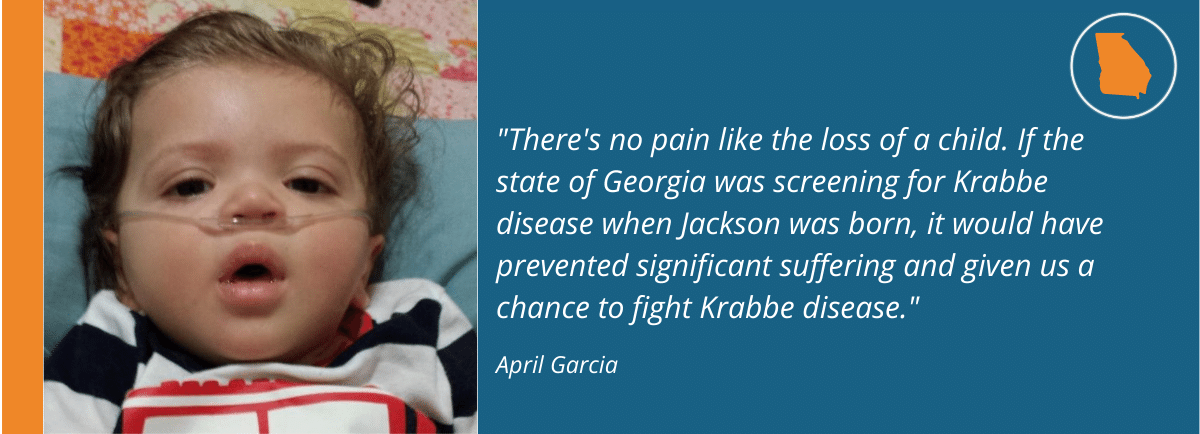DOWNLOAD STATE FACT SHEET AS PDF

In 2020, there were 122,473 live births in Georgia 2 There are 33 conditions on the Georgia Newborn Screening Panel 3
All babies in the United States are screened for several conditions shortly after birth. Approximately 24-48 hours after a baby is born in the United States, the heel is pricked by a nurse to collect a small sample of blood. Afterward, the nurse puts a series of blood drops onto a filter paper to create several “dried blood spots.” Next, the newborn screening card is sent to the state laboratory for analysis. April Garcia has become an advocate for Newborn Screening since the premature death of her son and was part of the efforts that led to a three-year pilot study being started in Georgia. Georgia started screening for Krabbe disease in September 2021 as part of a 3-year pilot study approved by Georgia NBS council.
What is Krabbe Disease?
Krabbe disease (pronounced krab A), is a rare genetic disorder, also known as globoid cell leukodystrophy. In the United States, Krabbe disease has been reported to affect approximately 1 in 100,000 individuals.1 Infantile Krabbe disease is the most common and severe form causing infants to lose the ability to eat, extreme irritability, inability to sit up, grasp objects, blindness, and seizures. Sadly, infants die within the first 2-3 years of life in states that do not test for Krabbe disease. We invite you to learn more at Understanding Krabbe Disease.
Why Screen for Krabbe Disease?
Krabbe disease is a severe neurodegenerative and rapidly progressing condition requiring immediate treatment for the most severe forms. Jackson was diagnosed with an early onset form of Krabbe disease at 6 months of age. This form, known as infantile Krabbe disease requires treatment within the first 30-45 days of life. Jackson was 6 months old at the time of diagnosis. Due to his delayed diagnosis palliative and supportive care where his only means of treatment. It’s important to note that all forms of Krabbe disease are significant and life-impacting however the infantile form is the most severe.
Krabbe Disease Hero: Jackson Garcia

See all our Krabbe Disease Heroes.
April and Daniel Garcia spent five days in the Pediatric Intensive Care Unit (PICU) with their six-month old son, Jackson, hoping for answers. On the fifth day, the hospitalist came into their room and asked them to walk down to a conference room, and also requested that they leave Jackson in his PICU room. April and Daniel protested this, having no idea what answers they were about to receive, and persuaded them to allow Jackson to come with them.
April remembered being surrounded by doctors in the conference room – the hospitalist, a neurologist, and a geneticist. The news to follow was worse than anything they had imagined: Jackson had Krabbe Disease and likely had one year to live. April described the meeting as sterile, bleak, and overwhelmingly hopeless. There was no care plan, action items, next steps, or support in any part of the discussion; in her words, “the open-ended presentation felt like an intervention for a habit not yet formed.” April and Daniel thought that a room full of providers would have produced some sort of care plan, however, nothing was provided prior to the conclusion of the meeting.
After diagnosis, April and Daniel’s mindset shifted to finding a new normal and working towards implementing a quality-filled life without pain for Jackson. Despite the impact of Krabbe Disease, Jackson found ways to communicate his likes and dislikes through grunting, closing his eyes, and purring when content. Sadly, Jackson lost his battle with Krabbe disease on October 21, 2016.
Resources
- The Leukodystrophy Newborn Screening Action Network is dedicated to advancing newborn screening for leukodystrophies and lysosomal storage disorders, supporting newly-diagnosed families, and ensuring collaboration between all stakeholders. Learn more at https://ldnbs.org/.
- CDC offers funding and assistance through the Newborn Screening Quality Assurance Program (NSQAP). More information can be found at https://www.cdc.gov/labstandards/nsqap.html.
- Baby’s First Test provides funding opportunities through grants. Learn more at https://www.babysfirsttest.org/newborn-screening/funding-opportunities.
- American Public Health Laboratories NewSTEPS program provides data, technical assistance, and training. Details at https://www.newsteps.org/.
- KrabbeConnect offers patient support services to help families navigate the burden of Krabbe disease. Learn more at https://krabbeconnect.org/.
- Hunter’s Hope Foundation is a non-profit organization committed to giving hope through education, awareness, research, and family care for all leukodystrophies. Learn more at https://www.huntershope.org/.
Citations
- Wenger DA. Krabbe Disease. 2000 Jun 19 [Updated 2011 Mar 31]. In: Pagon RA, Adam MP, Ardinger HH, et al., editors. GeneReviews® [Internet]. Seattle (WA): University of Washington, Seattle; 1993-2017.
- “Fertility Rate: Georgia, 2010-2020.” March of Dimes | PeriStats, https://www.marchofdimes.org/peristats/data?reg=99&top=2&stop=1&lev=1&slev=4&obj=1&sreg=51. Accessed 6 Sep. 2022.
- “Georgia | Baby’s First Test | Newborn Screening | Baby Health.” Babysfirsttest.org, 2015,
https://www.babysfirsttest.org/newborn-screening/states/georgia. Accessed 6 Sept. 2022.
All information in this fact sheet is based on data available before September 9, 2022.


